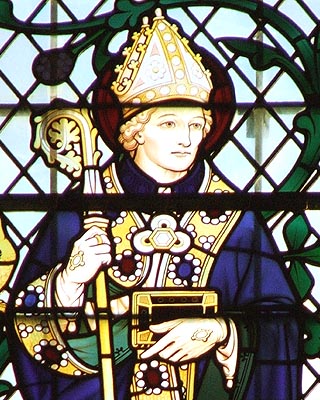
EBK Home
Kingdoms
Royalty
Saints
Pedigrees
Archaeology
King Arthur
Mail David
 St. Egwin,
St. Egwin,Bishop of Worcester
(Died AD 717)
St. Egwin was of the Royal Blood of the Mercian Kings, possibly a nephew of King Aethelred during whose reign, he was born at Worcester. He was elected Bishop of that city in AD 693. By his zeal in rebuking the illicit connections formed by some of the great men in his diocese and his vehemence in reforming the corrupt morals of all, he stirred up a party against him and, with the connivance of the King, he was expelled from his diocese. Egwin, meekly bending to his fate, determined to make a pilgrimage to Rome. According to a popular medieval legend, he also resolved to expiate certain sins of his youth, at the same time, by putting iron fetters on his feet, which were fastened with a lock. He then cast the key into the Avon. As he neared Italy, on a ship from Marseilles, a huge fish floundered upon deck and was killed and cut open. Much to the surprise of the Saint, in its belly, was found the key to his fetters. He accepted this as an expression of the will of heaven and released his limbs. According to another version of the story, the fish was caught in the Tiber, after St. Egwin had appeared before the Pope in Rome. The latter dismissed the charges against Edwin and he was soon restored to his diocese.
After his return, with the assistance of Coenred King of Mercia - and possibly St. Wilfred the Elder who founded seven unnamed Mercian monasteries around this time - St. Egwin founded the famous Abbey of Evesham. After this, he undertook a second journey to Rome, in company with both Coenred and King Offa of Essex. St. Egwin died on 30th December AD 717 and was buried in his Abbey at Evesham, to which his shrine brought many a medieval pilgrim. His relics were so popular that, when the abbey church required a major rebuilding in 1077, they were taken on a highly successful fund-raising tour of southern England, initiating miraculous cures at Dover, Oxford, Winchester and elsewhere. He is represented in art as a Bishop holding a fish with a key in its mouth.
Edited from S. Baring-Gould's
"The Lives of the Saints" (1877).
